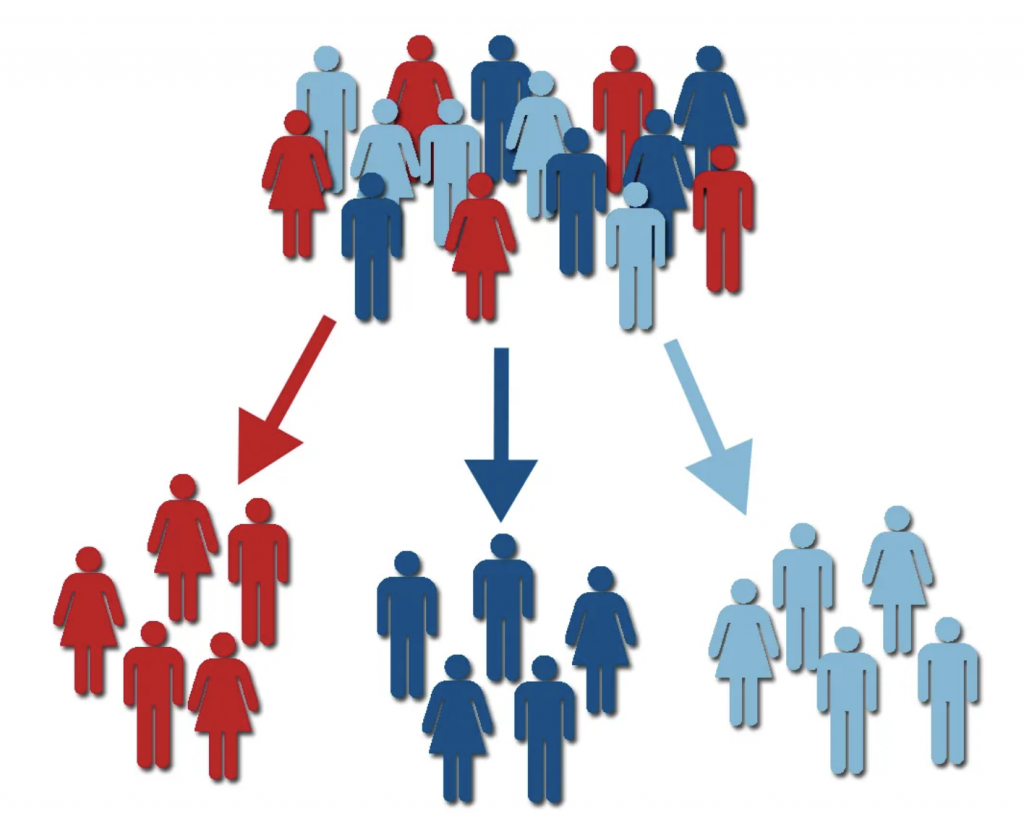blog»Digital Marketing»Segmented A/B Testing: The Key to Personalized E-commerce Strategies

Segmented A/B Testing: The Key to Personalized E-commerce Strategies
2024/05/28
You can read this article in about 21 minutes
Introduction
Understanding your customers is essential. This is where segmented A/B testing comes in. Segmented A/B testing lets you test different marketing ideas on specific groups of customers. Unlike regular A/B testing, which treats all users the same, segmented A/B testing recognizes that different customers have different needs and behaviors.
Using segmented A/B testing, you can learn what drives each group of customers to buy. This helps you create more personalized and effective marketing strategies. Whether you want to increase sales, reduce cart abandonment, or boost customer engagement, segmented A/B testing provides the detailed data you need.

In this article, we’ll dive into what segmented A/B testing is and why it’s important for e-commerce. We’ll also share real-life examples of businesses that have successfully used this strategy. Get ready to improve your e-commerce game with the power of segmented A/B testing.
What is Segmented A/B Testing?
Segmented A/B testing is a smart way to make your marketing efforts more effective. At its core, A/B testing compares two versions of a webpage, email, or other marketing elements to see which one performs better. But segmented A/B testing takes it a step further by dividing your audience into specific groups, or segments, and testing each group separately.
Imagine you run an online clothing store. Instead of testing a new homepage design on all visitors, you test it on different segments: new customers, returning customers, and VIP customers. Each group might react differently, giving you more precise insights.
Segmented A/B testing works by tailoring your tests to the unique behaviors and preferences of each segment. This means you can create more personalized experiences for your customers. For example, new customers might prefer a homepage that highlights bestsellers, while returning customers might want to see new arrivals or loyalty rewards.
The benefits of segmented A/B testing are clear. It allows you to understand your customers better, make data-driven decisions, and ultimately, increase your conversions. By focusing on the specific needs of different segments, you can create targeted marketing strategies that resonate with your audience and drive better results.
Why Segmented A/B Testing is Essential for E-commerce
Segmented A/B testing is a game-changer for e-commerce. It helps you understand your customers better and create marketing strategies that truly resonate with them. Here’s why it’s essential for your business.
Personalization is Key
In today’s market, customers expect personalized experiences. Segmented A/B testing lets you deliver just that. By testing different versions of your marketing materials on specific customer groups, you can see what works best for each segment. This means you can tailor your website, emails, and ads to meet the unique needs of different customer groups.

Get Targeted Insights
Regular A/B testing gives you a broad view of what works. But segmented A/B testing provides deeper insights. By analyzing the behavior of specific customer segments, you can understand their preferences and pain points better. This targeted insight helps you make more informed decisions and fine-tune your marketing strategies for better results.
Increase Conversion Rates
When you cater to the specific needs of different customer segments, you’re more likely to convert them. Segmented A/B testing allows you to identify what drives each group to take action. Whether it’s a new homepage design, a special offer, or a personalized email, you can optimize your marketing efforts to boost conversions.
Optimize Marketing Spend
With segmented A/B testing, you can allocate your marketing budget more effectively. By understanding which strategies work best for each segment, you can focus your resources on the most profitable tactics. This ensures you’re getting the best return on investment for your marketing efforts.
In summary, segmented A/B testing is crucial for e-commerce success. It helps you personalize your marketing, gain targeted insights, increase conversion rates, and optimize your spending. By understanding and addressing the unique needs of your customer segments, you can create more effective and impactful marketing strategies.
Steps to Implement Segmented A/B Testing
Implementing segmented A/B testing can seem complex, but breaking it down into clear steps makes it manageable. Here’s a straightforward guide to get you started:
Step 1: Define Your Goals
First, be clear about what you want to achieve. Are you looking to increase sales, reduce cart abandonment, or boost email open rates? Having specific goals will guide your testing process and help you measure success accurately.
Step 2: Identify Your Segments
Next, decide how to segment your audience. Common criteria include demographics (age, gender), behavior (new vs. returning customers), and purchase history (frequent buyers vs. occasional shoppers). Choose segments that are meaningful to your business and relevant to your goals.
Step 3: Create Hypotheses
For each segment, develop hypotheses about what changes might improve performance. For example, you might hypothesize that new customers will respond better to a homepage featuring popular products, while returning customers might prefer seeing new arrivals or loyalty rewards.
Step 4: Design Your Test
Now, design your A/B test. Create different versions of your marketing element (e.g., two different homepage designs). Ensure that each version is distinct and testable. It’s important to keep all other variables constant to isolate the impact of the changes you’re testing.
Step 5: Run the Test
Launch your A/B test and run it for a sufficient period to gather meaningful data. Ensure that each segment receives enough traffic to achieve statistically significant results. This might take a few days to a few weeks, depending on your website traffic and segment sizes.
Step 6: Analyze Results
After the test concludes, analyze the results. Look at how each segment responded to the changes. Did new customers prefer the new homepage design? Did returning customers engage more with personalized offers? Use this data to draw conclusions and make informed decisions.
Step 7: Implement and Iterate
Based on your analysis, implement the winning variations for each segment. But don’t stop there. Segmented A/B testing is an ongoing process. Continue to test new ideas and refine your strategies. Regularly review and adjust your segments as your business and customer base evolve.
By following these steps, you can effectively implement segmented A/B testing and gain deeper insights into your customers’ preferences. This approach helps you create more personalized and impactful marketing strategies, driving better results for your e-commerce business.
Real-life Example: Segmented A/B Testing at Zara
Zara, a leading global fashion retailer, is known for its ability to quickly adapt to changing fashion trends and customer preferences. To maintain its competitive edge, Zara uses segmented A/B testing to optimize its online shopping experience and drive higher conversion rates. Here’s a closer look at how Zara successfully implemented segmented A/B testing.

Segment: New vs. Returning Customers
Zara wanted to understand how different customer segments responded to various homepage layouts. They decided to focus on two primary segments: new customers and returning customers. The hypothesis was that new customers might prefer seeing popular products and easy navigation, while returning customers might be more interested in new arrivals and personalized recommendations.
Test Design
Zara designed two different versions of their homepage:

- Version A (for new customers): This version featured a clean, straightforward design highlighting bestsellers, easy navigation, and a prominent call-to-action (CTA) for new customers to sign up for a newsletter and get a discount.
- Version B (for returning customers): This version emphasized new arrivals, personalized product recommendations based on past purchases, and a loyalty program CTA.
Running the Test
The test was run for four weeks, ensuring that each segment received a significant amount of traffic. Zara used cookies and user login data to accurately segment the customers and serve them the appropriate homepage version.
Analyzing the Results
The results of the segmented A/B test were clear and insightful:
- New Customers: Version A led to a 15% increase in newsletter sign-ups and a 10% increase in the average time spent on the website. New customers appreciated the straightforward layout and the attractive offer for signing up.
- Returning Customers: Version B resulted in a 20% increase in repeat purchases and a 25% boost in engagement with the loyalty program. Returning customers valued the personalized recommendations and felt more rewarded by the loyalty program.
Implementation and Iteration
Based on these results, Zara implemented Version A for new customers and Version B for returning customers. The insights gained from this test also informed future marketing strategies, such as personalized email campaigns and targeted promotions.
Continuous Improvement
Zara continues to use segmented A/B testing as an integral part of their marketing strategy. By regularly testing and refining their approach, they stay responsive to their customers’ needs and preferences, ensuring a consistently high-quality shopping experience.
This example of segmented A/B testing at Zara illustrates how understanding and catering to different customer segments can significantly enhance an e-commerce business’s performance. By leveraging these insights, Zara successfully increased conversions, improved customer satisfaction, and maintained its position as a leader in the fast-paced fashion industry.
Best Practices for Segmented A/B Testing
To get the most out of segmented A/B testing, follow these best practices. Keeping things simple and focused will help you achieve clear and actionable results.
- Use Clean and Accurate Data
Start with reliable data. Make sure your customer segments are correctly identified and based on accurate information. Clean data leads to better insights and more effective testing. - Choose Meaningful Segments
Segment your audience in ways that make sense for your business. Common segments include new vs. returning customers, different age groups, or device types (mobile vs. desktop). The key is to choose segments that will provide useful insights for your goals. - Test One Variable at a Time
To understand what truly affects your customers’ behavior, change only one variable in your test. For example, if you’re testing homepage designs, keep everything else constant. This way, you can clearly see which version performs better. - Ensure Adequate Sample Size
For your test results to be meaningful, each segment needs a sufficient number of users. Too small a sample can lead to inaccurate conclusions. Aim for a large enough audience to achieve statistically significant results. - Run Tests for an Appropriate Duration
Give your test enough time to gather meaningful data. Depending on your traffic, this could be a few days to a few weeks. Ending a test too early might lead to misleading results. - Monitor External Factors
Be aware of external factors that could influence your test results, such as holidays, promotions, or market changes. These factors can skew your data and affect the accuracy of your findings. - Analyze and Act on Results
Once your test is complete, analyze the data carefully. Look for clear trends and insights. Use these findings to make informed decisions and improve your marketing strategies. - Keep Testing and Iterating
Segmented A/B testing is an ongoing process. Continuously test new ideas and refine your strategies based on what you learn. Regular testing helps you stay responsive to your customers’ changing preferences.
By following these best practices, you can effectively implement segmented A/B testing and gain valuable insights into your customers’ behaviors. This will help you create more personalized and impactful marketing strategies, driving better results for your e-commerce business.
Conclusion
Segmented A/B testing is a powerful tool for e-commerce marketers. By understanding and addressing the unique needs of different customer segments, you can create more personalized and effective marketing strategies. This approach leads to higher conversion rates, better customer engagement, and optimized marketing spend. Start implementing segmented A/B testing today to unlock the full potential of your e-commerce business and stay ahead in the competitive market.